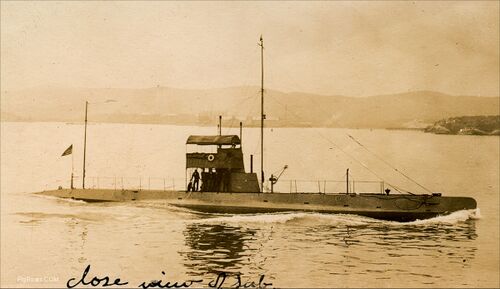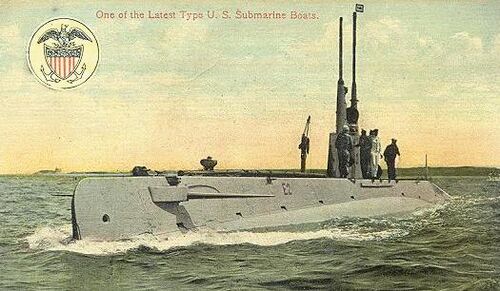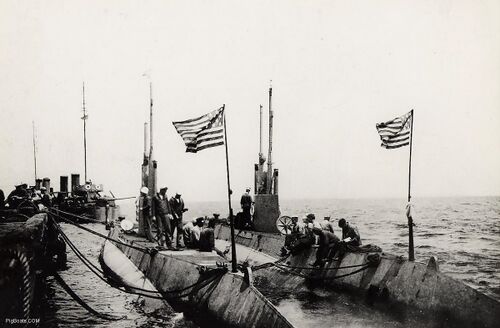E-class: Difference between revisions
Pbcjohnston (talk | contribs) (Added pictures and captions) |
Pbcjohnston (talk | contribs) (→Design, Construction, and Naming Notes: Rewrote the Notes section) |
||
| (8 intermediate revisions by the same user not shown) | |||
| Line 1: | Line 1: | ||
[[File:E-Boat Header 1.jpg|center]] | [[File:E-Boat Header 1.jpg|center]] | ||
=== <big>Design, Construction, and Naming Notes</big> === | === <big>Design, Construction, and Naming Notes</big> === | ||
<div style="text-align: justify;"><span style="color:#00008B">The E-class harbor defense submarines were built to an Electric Boat Company design at the Fore River Shipbuilding Company in Quincy, MA. | <div style="text-align: justify;"><span style="color:#00008B">The E-class harbor defense submarines were built to an Electric Boat Company design at the Fore River Shipbuilding Company in Quincy, MA. The gasoline engines that had powered all previous submarines carried some tremendous liabilities; the gasoline fumes sickened the crew and the vapors were very flammable. Diesel fuel was much more stable and diesel engines had a much higher power-to-weight ratio. Electric Boat in particular heavily favored the use of the new engines. Thus, the Navy Department ordered two submarines in Fiscal Year 1909 to be powered by diesels; the first USN boats to be powered by this engine type. The E-class boats were really just diesel powered D-boats, with a very similar size and the same armament. | ||
[[File:Red bar sub new.jpg]]< | |||
=== <big>E-1 (Submarine No. 24, later SS-24)</big> === | The rapidly increasing size of USN submarines was showing that the typical single set of stern diving planes was becoming inadequate for underwater control. A second set of planes near the bow would provide precise depth control while the stern planes would continue to provide angle control. Grayling of the D-class had experimented with the concept and it proved to be entirely successful. The E-class boats would be the first submarines in the USN to be equipped with bow diving planes as standard equipment. | ||
[[File:E-1 underway-2.jpg|left| | |||
<div style="text-align: justify;"><span style="color:#00008B">The E-1 is seen here at an unidentified location, possibly Ponta Delgada, Azores, summer 1918. E-1 was a pathfinder, the first USN submarine with bow diving planes, seen here folded up alongside the forward superstructure. The bow planes were used to keep a precise depth, and the stern planes were used to control the up or down angle while running submerged. The E-class boats were also the first to have diesel engines. In this photo E-1 is either starting or finishing a long surface run, evidenced by the extensive bridge structure and the tall radio masts. All of this topside clutter would have to be disassembled and stowed below before the boat could dive, a process estimated to take at least 45 minutes.</span | These two boats were originally named Skipjack and Sturgeon. On November 17, 1911, after launching but prior to being commissioned, the Navy changed its naming convention for submarines and these boats received their E-class names. Both boats were redesignated from their original general submarine designations to the new SS series on July 17, 1920. | ||
E-2 suffered a serious battery explosion and fire on January 15, 1916 while undergoing tests on a new battery type at the Brooklyn Navy Yard near New York City. Unfortunately, four men were killed and seven were seriously injured. For a better explanation of this incident, please see the [[Notable Submarine Accidents|'''Notable Submarine Accidents''']] page for more information.</span> | |||
[[File:Red bar sub new.jpg]] | |||
<div style="text-align: justify;"><span style="color:#000000"> | |||
=== <big>Skipjack/E-1 (Submarine No. 24, later SS-24)</big> === | |||
</div> | |||
[[File:E-1 underway-2.jpg|left|500px|Photo in the private collection of Ric Hedman]] | |||
<div style="text-align: justify;"><span style="color:#00008B">The E-1 is seen here at an unidentified location, possibly Ponta Delgada, Azores, summer 1918. E-1 was a pathfinder, the first USN submarine with bow diving planes, seen here folded up alongside the forward superstructure. The bow planes were used to keep a precise depth, and the stern planes were used to control the up or down angle while running submerged. The E-class boats were also the first to have diesel engines. In this photo E-1 is either starting or finishing a long surface run, evidenced by the extensive bridge structure and the tall radio masts. All of this topside clutter would have to be disassembled and stowed below before the boat could dive, a process estimated to take at least 45 minutes.</span> | |||
[[E-1|See More E-1 photos]] | [[E-1|See More E-1 photos]] | ||
| Line 12: | Line 24: | ||
[[File:Red bar sub new.jpg]] | [[File:Red bar sub new.jpg]] | ||
=== <big>E-2 (Submarine No. 25, later SS-25)</big> === | <div style="text-align: justify;"><span style="color:#000000"> | ||
[[File:E2a.jpg|left| | |||
=== <big>Sturgeon/E-2 (Submarine No. 25, later SS-25)</big> === | |||
</div> | |||
[[File:E2a.jpg|left|500px|Photo in the private collection of Ric Hedman]] | |||
<div style="text-align: justify;"><span style="color:#00008B">A color postcard image of E-2 underway with her bow planes rigged out, either just after or shortly before a dive. Date is approximately 1912-1913. Location is unknown, but could possibly be Narragansett Bay, R.I.</span> | <div style="text-align: justify;"><span style="color:#00008B">A color postcard image of E-2 underway with her bow planes rigged out, either just after or shortly before a dive. Date is approximately 1912-1913. Location is unknown, but could possibly be Narragansett Bay, R.I.</span> | ||
| Line 19: | Line 35: | ||
[[File:Red bar sub new.jpg]] | [[File:Red bar sub new.jpg]] | ||
<div style="text-align: justify;"><span style="color:#000000"> | |||
=== <big>General E-class Photos</big> === | === <big>General E-class Photos</big> === | ||
[[File:E-1 n e-2-a.jpg|left| | </div> | ||
[[File:E-1 n e-2-a.jpg|left|500px|USN photo courtesy of Michael Mohl at Navsource.org.]] | |||
<div style="text-align: justify;"><span style="color:#00008B">E-1 and E-2 moored together at an unknown location, approximately 1912. There is a destroyer in the background. The crew are relaxing topside, indicating that this is the conclusion of a long run at sea. One crewman on the right appears to be reading a magazine.</span> | <div style="text-align: justify;"><span style="color:#00008B">E-1 and E-2 moored together at an unknown location, approximately 1912. There is a destroyer in the background. The crew are relaxing topside, indicating that this is the conclusion of a long run at sea. One crewman on the right appears to be reading a magazine.</span> | ||
| Line 27: | Line 47: | ||
[[File:Red bar sub new.jpg]] | [[File:Red bar sub new.jpg]] | ||
<center>[[Submarine Classes|Return to the Submarine Classes page]]</center> | |||
[[File:Red bar sub new.jpg]] | |||
<center> | |||
Page created by:<br> | |||
<span style="color:#00008B"> | |||
<small>Ric Hedman & David Johnston<br> | |||
1999 - 2023 - PigBoats.COM<sup>©</sup><br> | |||
Mountlake Terrace, WA, Norfolk, VA<br> | |||
webmaster at pigboats dot com</small> | |||
</center> | |||
[[File:Subs bottom line 2.jpg]] | |||
Latest revision as of 15:05, 17 December 2023

Design, Construction, and Naming Notes
The rapidly increasing size of USN submarines was showing that the typical single set of stern diving planes was becoming inadequate for underwater control. A second set of planes near the bow would provide precise depth control while the stern planes would continue to provide angle control. Grayling of the D-class had experimented with the concept and it proved to be entirely successful. The E-class boats would be the first submarines in the USN to be equipped with bow diving planes as standard equipment.
These two boats were originally named Skipjack and Sturgeon. On November 17, 1911, after launching but prior to being commissioned, the Navy changed its naming convention for submarines and these boats received their E-class names. Both boats were redesignated from their original general submarine designations to the new SS series on July 17, 1920.
E-2 suffered a serious battery explosion and fire on January 15, 1916 while undergoing tests on a new battery type at the Brooklyn Navy Yard near New York City. Unfortunately, four men were killed and seven were seriously injured. For a better explanation of this incident, please see the Notable Submarine Accidents page for more information.
Skipjack/E-1 (Submarine No. 24, later SS-24)

Sturgeon/E-2 (Submarine No. 25, later SS-25)

General E-class Photos

See more General E-class Photos
Page created by:
Ric Hedman & David Johnston
1999 - 2023 - PigBoats.COM©
Mountlake Terrace, WA, Norfolk, VA
webmaster at pigboats dot com